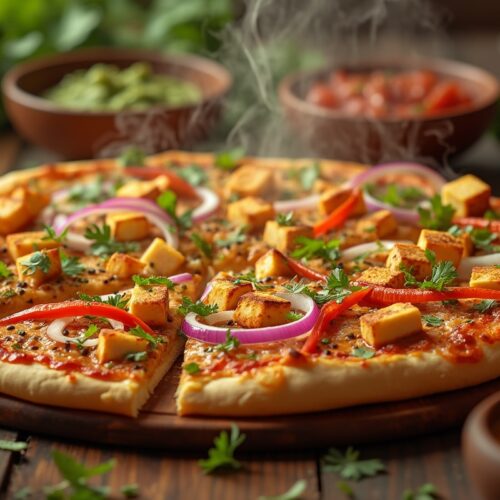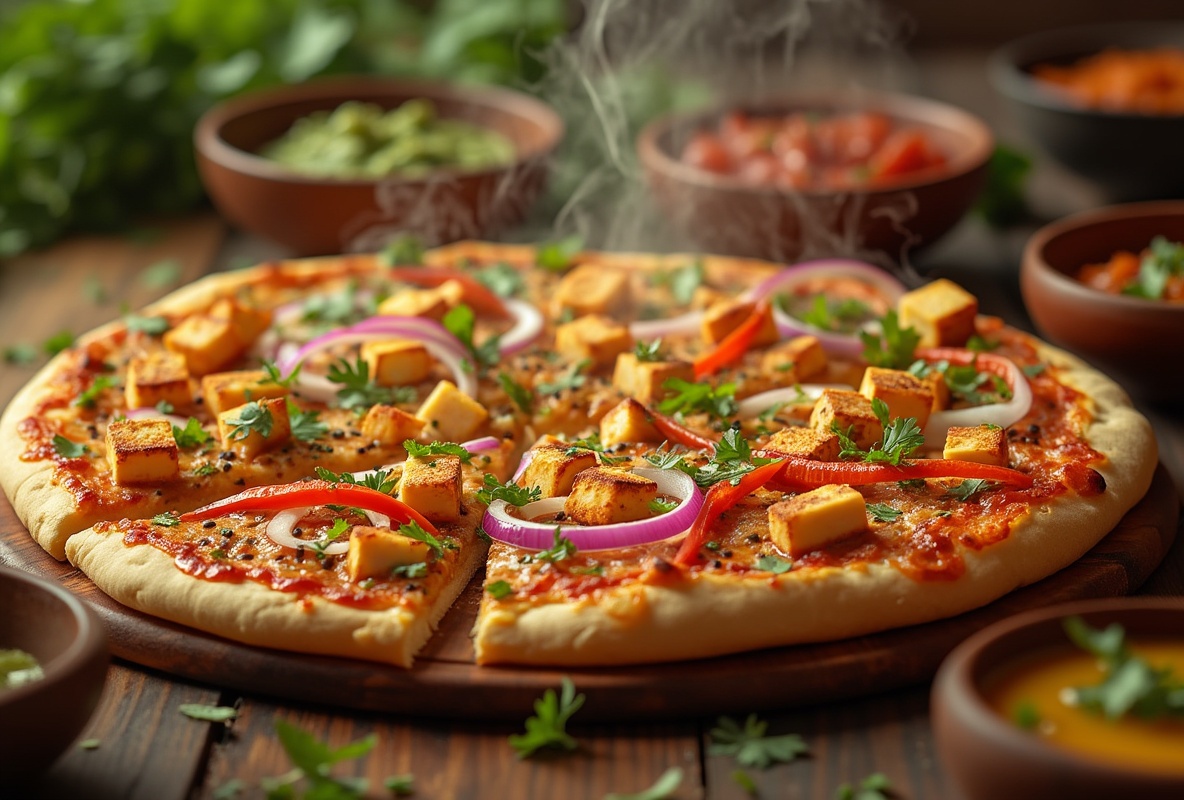Understanding the Roots of Desi Pizza
Have you ever wondered about the origins of Desi Pizza? In this section, we’ll dive into “Desi Pizza Explained” and uncover how this delectable fusion marvel came to be. Born from the creative melding of traditional Italian pizza with the bold and diverse flavors of South Asian cuisine, Desi Pizza offers a taste adventure unlike any other. With its unique use of spices and toppings, this culinary innovation reflects a rich tapestry of cultural influences. So, as we explore its roots, let’s appreciate how it beautifully bridges two vibrant culinary worlds.
The Evolution of Unique Flavor Profiles
Over time, Indian-Spiced Pizza has evolved into a delightful culinary art. It brings a bouquet of flavors that beautifully blend East and West. This transformation combines traditional Italian pizza elements with vibrant Indian cuisine influences. Spices like cumin, coriander, and turmeric add rich, aromatic depth to the pizza experience.
Food enthusiasts have embraced this fusion concept wholeheartedly. Tangy chutneys and robust curry sauces now play key roles in the mix. Toppings like paneer and tandoori chicken enhance the flavor palette, creating a taste sensation that’s both familiar and exciting. The result is a symphony of flavors that dance on your palate. It offers bold textures and comforting tastes.
This innovative journey marries traditional spices with pizza, delivering more than just heat. It brings a soulful charm that makes every bite an adventure. To complement these bold flavors, consider honing your knife skills. Preparing fresh ingredients with precision can elevate your cooking even further.
Desi Pizza Explained: A Fusion Recipe Overview
Indian-Spiced Pizza is a culinary marvel that brings together the tantalizing spices of India and the beloved format of traditional pizza. This fusion dish is not just about adding a few spices; it’s a delightful blend where paneer, tangy chutneys, and fresh cilantro meet gooey mozzarella and crispy crusts. The result is an array of flavors that range from sweet to savory, with a hint of heat provided by chili peppers or garam masala. Each ingredient plays its own role, creating a harmonious balance that pleases the palate. Let’s walk through the recipe together to bring this to life. For those venturing into plant-based adaptations, learn how vegan cheese ingredients can elevate your fusion dishes.

Indian-Spiced Pizza
Equipment
- Rolling Pin
- Baking sheet or pizza stone
- Parchment paper
- Mixing bowl
- Knife
- Spatula
Ingredients
- 1 store-bought pizza dough or homemade
- 1/2 cup tomato sauce
- 1 tbsp curry powder
- 1 tsp garam masala
- 1 cup mozzarella cheese shredded
- 1 cup paneer cubed
- 1/2 cup red onion thinly sliced
- 1/2 cup bell peppers thinly sliced
- 1/4 cup cilantro leaves chopped
- 1 tbsp olive oil
Instructions
- Preheat the oven to 475°F (245°C) and place a pizza stone or baking sheet inside to heat.
- Roll out the pizza dough into a circular or rectangular shape on parchment paper.
- Mix the tomato sauce with curry powder and garam masala in a small bowl, then spread the mixture evenly over the dough.
- Sprinkle shredded mozzarella cheese over the sauce, followed by cubed paneer, sliced red onions, and sliced bell peppers.
- Drizzle olive oil over the assembled pizza.
- Carefully transfer the pizza (with parchment paper) onto the preheated pizza stone or baking sheet.
- Bake for 15-20 minutes or until the crust is golden and the cheese is bubbly and melted.
- Remove the pizza from the oven, sprinkle chopped cilantro leaves on top, and let it cool for 2-3 minutes before slicing.
Notes
Popular Ingredients in Desi Pizza
When crafting the perfect Indian-spiced pizza, it’s all about the vibrant and aromatic ingredients that set it apart. In my experience, a classic desi pizza often starts with a base of naan or flatbread, which provides a robust foundation to hold a variety of toppings. Instead of the traditional tomato sauce, you might find a rich, spiced curry or a creamy tikka masala as a flavorful spread. Paneer, an essential feature in Indian cuisine, acts as a flavorful counterpart to mozzarella, bringing its unique texture and mild taste.
Then come the delightful toppings. Bell peppers, red onions, and fresh cilantro add freshness and color, while toppings like tandoori chicken, spicy lamb, or even garam masala-infused veggies offer boldness that makes this fusion dish stand out. Some might add roasted cumin or coriander seeds for that extra aromatic kick. Lastly, a drizzle of tangy chutney or a sprinkle of chaat masala can elevate the flavor profile to new heights. With such an array of ingredients, each slice tells a story of cultural harmony and culinary innovation.
Comparing Desi Pizza with Traditional Italian Pizza
When we compare Desi Pizza and traditional Italian pizza, we enter a world of fascinating culinary contrasts. Classic Italian pizza is celebrated for its simplicity. It often features fresh basil, mozzarella, and tomatoes on a thin, crispy crust. In contrast, Desi Pizza tells a bold and flavorful story.
This Indian-inspired creation blends spices and flavors to add an exciting twist to the pizza experience. Picture a mix of paneer, tikka masala sauce, and green chilies atop a chewy, flavorful crust. Vibrant spices like turmeric, cumin, and coriander infuse the pizza with an aromatic punch. These elements reflect the rich tapestry of Indian cuisine.
Unlike the Neapolitan principle of “less is more,” Desi Pizza embraces “more is more.” It features hearty flavors and bold ingredients that delight the palate. If you enjoy robust flavors paired with simplicity, try the one-pan lemon garlic chicken and asparagus for a balanced dish. Both pizza styles offer unique experiences, making this fusion journey even more intriguing.
Exploring Regional Variations of Desi Pizza
When it comes to Indian-Spiced Pizza, the diversity is nothing short of fascinating. Each region in India has its own twist on this delicious fusion. In the north, you’ll find pizzas topped with paneer tikka and spiced with cumin and coriander. Moving to the western parts, especially in Mumbai, pav bhaji masala becomes a star ingredient, giving pizzas a unique tangy flavor. Down south, where rice dishes and coconut milk rule, you’ll encounter pizzas that might surprise you with spicy sambhar or curry leaf garnishments. Meanwhile, eastern regions are known for incorporating mustard oil and fish, adding an unconventional yet delightful taste to the Indian-Spiced Pizza. This variety reflects India’s rich culinary tapestry. Each slice invites you to experience a new spectrum of spices, from the robust to the subtly aromatic. By diving into these regional specialties, one’s palate is truly taken on a flavorful journey across the vast landscapes of India.
Tips for Making Perfect Desi Pizza at Home
Making Indian-Spiced Pizza at home involves blending exotic ingredients with precise techniques. First, choose a fluffy, naan or whole-wheat base to give your pizza the authentic touch. For the sauce, mix traditional pizza sauce with spices like garam masala and cumin to create a vibrant flavor profile that stands out. When it comes to toppings, consider a range of options such as paneer, tandoori chicken, or an array of colorful vegetables like red onions and bell peppers.
To elevate the taste, sprinkle some coriander or cilantro leaves and drizzle tamarind chutney or mint yogurt on top as a final touch. For more insight on how to master essential kitchen techniques, check out essential knife skills for home cooks. A hot oven preheated to the right temperature is crucial for that perfect crispy crust, so aim for around 475°F. Remember, experimenting is key: adjust the spices and toppings according to your preference, exploring the diversity of South Asian flavors. With these tips, you’re set to embark on a culinary journey right in your kitchen, creating a desi pizza that’s both flavorful and uniquely satisfying.
Frequently Asked Questions
How can I ensure the crust stays crispy on my Indian-Spiced Pizza?
To keep your Indian-Spiced Pizza crust crispy, preheat your baking tray or pizza stone before putting your pizza on it. This ensures the heat hits the base right away, creating a deliciously crispy crust. Also, be cautious with how much sauce you use, as too much can make the crust soggy.
How do I bring out the flavors of Indian spices in my pizza?
To truly bring out the depth of Indian spices in your pizza, consider lightly toasting whole spices before grinding them, or sautéing ground spices in a bit of oil to release their essential oils. This step intensifies their flavor, making your Indian-Spiced Pizza taste authentic.
Can I freeze Indian-Spiced Pizza?
Yes, you can freeze Indian-Spiced Pizza! Just ensure it’s fully cooled before tightly wrapping slices in plastic wrap and foil. This way, it preserves its flavors. To reheat, pop it back into a preheated oven for the best experience, avoiding the microwave if possible to retain its crispy texture.
What’s the difference between Desi Pizza and Indian-Spiced Pizza?
Desi Pizza is a term often used in South Asia and refers to a broader category of pizzas that incorporate various local flavors and ingredients, while Indian-Spiced Pizza specifically features classic Indian spices, giving it a distinct Indian flavor profile. Both are delicious fusions worth trying!
How can I make my Indian-Spiced Pizza less spicy?
If you find your Indian-Spiced Pizza too spicy, reduce the amount of chili powder or fresh chilies used in the recipe. You can also add some yogurt or cream to the sauce, which will help balance and mellow the heat while adding a creamy richness. For more culinary substitutions, you can explore ideas like substitute meat with lentils to enhance the nutritional profile of your dish.

